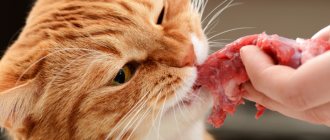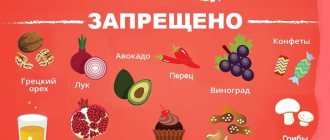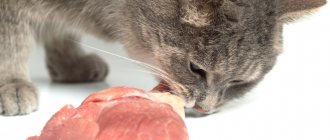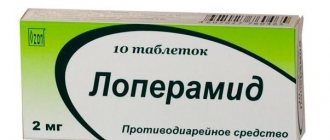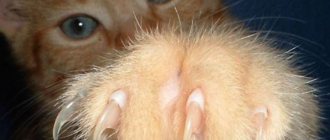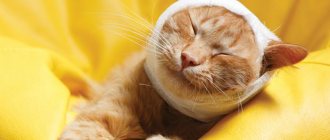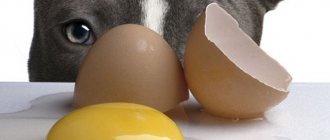It is widely believed that many foods can be given to a cat in their raw, original form, and nothing will happen to the animal. Is it so? Can cats eat raw meat and other raw foods? Is this kind of feeding beneficial for a cat? Let's try together to consider this issue in more detail and understand all the nuances.
Many, even experienced cat owners, are not really well versed in the issue of proper feeding of their mustachioed pets. It seems that there is nothing difficult in this - feed with ordinary food that people eat themselves, and that’s the end of it. However, everything is not so simple, and the animal’s body treats many products in a completely different way than it seems to people.
As many adherents of raw feeding quite rightly believe, cats in nature do not prepare their own food, but eat their prey raw. This is precisely why people argue that cats should be fed raw foods - they say that it is healthier and more natural for the cat’s body. However, here the first argument against it arises: our pets are no longer the wild cats that got their food in nature, which means that in the course of selection and long coexistence with humans, domestic cats have significantly changed their lifestyle, as well as their digestion. That is why there is no clear answer to the question of whether cats can eat raw meat - it all depends on many factors. Let's discuss the different types of foods and their effects in raw form on the body of domestic cats.
What role does it play in a cat's diet?
Everyone knows that cats are predators. Therefore, raw meat for these animals is a natural and main component of the diet. The share of this product in the daily cat menu can reach up to 80%. Regular consumption of meat provides the cat with the necessary proteins and amino acids, which play a key role in the formation of the bone skeleton and muscle tissue.
Is it worth feeding a cat raw meat? Many owners are interested in it.
Their deficiency, especially taurine, can cause serious health problems and can lead to:
- blindness;
- deterioration of wool quality;
- baldness;
- heart failure;
- disruption of the normal functioning of the endocrine system.
For your information! Some breeders try to compensate for taurine deficiency by including foods rich in plant protein in the cat's diet.
However, it should be noted that in protein foods of plant origin there is either no taurine at all, or it is found in negligible quantities.
Safe types for cats
Is it possible to feed a dog raw meat or is it better to cook it?
Many people will be interested to know which meat is most suitable for a fluffy, which type of meat should be given with some restrictions, and which meat product should be completely abandoned.
Lean beef
Lean beef contains the highest amount of protein and taurine. This is the meat that should be preferred. In addition, beef has virtually no fat, which is bad for the digestive system, especially the liver.
Lean lamb
You can diversify your cat's diet by adding lean lamb. Just like beef, lamb can be offered to your pet in small portions daily.
Rabbit meat
Rabbit meat is ideal for those cats that are weakened, are going through a period of recovery from illness, or are obese. Being hypoallergenic, soft, with a loose fibrous structure, it is perfectly absorbed by the cat's body.
Not all meat is equally healthy for cats
Chicken meat
Chicken is an excellent choice for feeding your pet, provided it is of high quality. Low-quality chicken, containing hormones and antibiotics, can significantly harm the cat.
Important! Bones should be removed from chicken meat. That is why you should give preference to chicken breast. In addition, you should not give your cat chicken skin, which may contain an increased concentration of harmful substances.
Turkey
Like chicken, turkey meat is hypoallergenic and ideal for cats. In this case, its quality is of key importance. You should not buy meat in thermal packaging, as in this case it will be extremely difficult to assess its condition. In addition, turkey meat, like chicken, may contain hormones and antibiotics that were used in the process of raising poultry on a farm.
Note! Veterinarians recommend feeding your cat turkey, alternating with lean lamb.
By-products
Tailed pets will quite like offal - liver, lung, tripe, heart, kidneys. In addition, their benefits for the cat’s body are undeniable, since they contain iron and fat-soluble vitamins A and D, which the cat’s body needs. However, it is not recommended to give offal to cats every day. Two or three times a week in portions of 50-70 g will be enough.
Raw fish
Experts do not recommend giving raw fish to your cat, as there is a high probability of the animal becoming infected with helminthiasis. It is best to offer your pet heat-treated fish in a portion of no more than 150-200 g per week.
Important! If raw fish, especially lake or river fish, is still present in the cat’s menu, anthelmintic measures should be carried out regularly.
LiveInternetLiveInternet
Your_Veterinarian_Doctor
all posts by the author Many owners want their cat to receive nutrition that is as close to natural as possible. And since it is a carnivorous predator, its body is maximally adapted to digest raw meat.
But is all meat good for your pet?
When feeding meat, you need to understand that it and offal contain very little calcium, and the calcium/phosphorus balance for a healthy animal should be 1:1. The situation can be corrected by adding a mineral supplement with calcium to the cat's food or by using whole chicken carcasses, chicken necks, rabbit heads and carcasses in the diet. Choosing meat
If you think you can save money by buying cheap meat products like trimmings, pork heart, chicken feet and heads for your pet, think about the cost of veterinary care! After all, this is exactly what you will have to spend money on after such and such nutrition. It is better to buy meat in pieces, rather than trimmings, which is the surface layer from pieces of meat, dried out, covered with bacteria and it is not known whether the pile of trimmings is beef, pork or lamb. Perhaps even everything mixed together. The cat senses the decomposition process that has begun and may refuse such food. But flank meat is not inferior in nutritional value to tenderloin, but costs 2-3 times less, and this is exactly where you can save money. Beef, horse meat, poultry, and rabbit are the most preferred meats for feeding cats. It has high nutritional value, is rich in taurine and is easily digestible, suitable for feeding cats even with problematic health. Pork and its by-products should not be given to cats that have problems with excess weight, genitourinary or digestive systems, joints or liver. In addition, excess fat impairs the absorption of protein and calcium, and increases the need for vitamins. When feeding raw pork, there is a risk of contracting trichinosis. Trichinella larvae easily tolerate prolonged cooling and heating of meat. They can only be killed by cooking for at least two and a half hours with pieces of meat no more than 8 cm thick. Raw meat must be refrigerated for 7-10 days at a temperature of -18-20 °C. Bacteria and most eggworms die at this temperature, but not Trichinella, which sometimes infects pork. By-products Of all by-products, heart and liver are the most preferable for feeding cats. Liver in its raw form often causes diarrhea, so it is added to the feed a little. This product is also rich in vitamin A, an excess of which causes A-hypervitaminosis. If you feed your cat only offal, cereals and vegetables, its body will lack the essential amino acids lysine, methionine and tryptophan. Therefore, for a balanced diet, it is enough that the heart and liver make up approximately 1/5 of the cat’s diet. Taurine Taurine is an absolutely essential amino acid for cats that cannot be synthesized by them on their own. However, with its prolonged deficiency, the cat may lose vision, there may be disturbances in the functioning of the cardiovascular system, a weakening of the reproductive functions of the body, and a general deterioration in well-being. There is no taurine in vegetables and cereals. There is very little of it in milk, dairy products and eggs. Most taurine is found in seafood, whole chickens, dark chicken and turkey meat. If you feed your cat boiled meat, you need to know that taurine is washed out of the meat during cooking. Therefore, it is better to stew the meat in its own juices or boil it in a very small amount of water, and then use this broth for cooking. Carbohydrates Of course, we will not feed the cat only meat. She also needs to receive a small amount of carbohydrates, which she has adapted to digest over a long period of coexistence with humans. Carbohydrates in the form of starch are found in rice and other grains. To ensure that starch is well absorbed, it is recommended to soak the cereal and thoroughly boil it before cooking. If the proportion of cereals in a cat's diet is too high, the absorption of starch will worsen and it will cause fermentation in the intestines. Vegetables Vegetables are not a cat's main source of nutrition. They are usually added to meat in a well-cooked and crushed form to improve intestinal motility and provide some missing vitamins: A, C and others. How much does it weigh in grams? To find out how much food to give your pet daily, you need to weigh it. Young cats and kittens should eat about 10% of their body weight per day when fed natural foods. Adult cats - 5%. This means that an adult animal weighing 3 kg should receive about 150 grams of food per day, and a young animal with the same weight should receive 2 times more. The share of meat and offal in the diet should be about 70%, cereals about 10%, and vegetables about 20%. Why is it dangerous to combine different types of feeding? The quality and composition of gastric juice depends on what the cat eats. If she eats meat, then her gastric juice is enriched with enzymes and has maximum acidity, which promotes improved digestion of the protein diet. A carbohydrate diet leads to a decrease in the amount of gastric juice, so you cannot suddenly change one diet to another; the transition should be made gradually. In the intestines, the food eaten is affected by intestinal juice, pancreatic juice and bile. The composition of enzymes in the pancreas depends on the diet and composition of feeding; a sudden change can cause pancreatic upset. The composition of intestinal juice also changes depending on food. This is why mixed feeding of dry industrial food and natural food often leads to problems with the health of the animal.
Author Elena Gerasimova Felinologist, breeder of Balinese cats, owner of the Balinese cattery “Dizigner” of the Dizigner company
Link to source https://animal.ru/cat/articles/Which_meat_for_a_cat_is/.
What is the best way to feed meat?
Is it possible to feed a cat dog food - wet or dry and what is the difference?
Despite the fact that raw meat is one of the main components of the cat's table, it must be given wisely. If you neglect the rules developed by specialists, you can get serious problems in the form of helminthiasis or infectious diseases. List of useful recommendations:
- before offering a raw meat product to your pet, it should be frozen in the freezer for at least 3-4 days;
- meat for cats should be cut into small cubes or ground into minced meat;
- You should not give your cat frozen or cold deli meat, as the cat may catch a cold or damage its tooth enamel. Before serving, it must be defrosted to room temperature;
- raw meat for cats should not contain any spices or salt.
Raw meat dishes should not contain salt or spices
How to secure meat before feeding
To destroy bacteria and parasites, it is necessary to freeze the meat before feeding the cat.
Some parasites and bacteria contained in meat products of animals and birds can be killed by freezing above 20 degrees from 24 hours to one week. Also by boiling meat. However, some nutrients disappear during cooking, for example, taurine, which is necessary for the health of the animal.
It is important to monitor the quality of meat products and their expiration dates. Do not allow your pet to feed leftovers, scraps or spoiled meat.
It was better to purchase meat from local livestock and chicken breeders.
It is necessary to store meat used to feed a cat at a temperature no higher than 5ﹾC and serve the animal the amount that it will consume at one time, so that the leftovers do not spoil.
What meat should be excluded from a cat's diet?
Is it possible to feed a cat both dry and wet food at the same time: examples of mixing
Offering fatty meat to your sofa pet is a very bad idea, as it can negatively affect the digestive system. We are talking primarily about the following varieties:
- pork;
- lamb (fat parts of the carcass);
- duck and goose;
- ready-made minced meat from the supermarket;
- large bones.
Important! Being fragile and brittle, the tubular bones of a bird can damage the internal digestive organs of a cat. Therefore, you should carefully ensure that they are not in your pet’s diet.
Prohibited species
There are certain types of meat that should not be given to a cat, even if the product is very good and high quality. This is especially important for pets living in comfortable conditions, since their metabolic processes have already been rebuilt.
First of all, cats are not given pork or any other fatty varieties. These include duck and goose. Even a small amount of pork provokes the development of obesity in a cat. For the same reason, it is forbidden to feed minced meat: it contains a huge amount of fat, which is harmful to the animal.
You should not give meat from an old cow, chicken, etc. Its taste and nutritional qualities deteriorate excessively, and such a diet can make the animal sick. Carrion is also prohibited, because it is a source of pathogenic microflora and serious diseases.
It is forbidden to feed a cat bones. They are not digested in the stomach. Large amounts of bone cause intestinal obstruction. In addition, sharp fragments can injure the stomach and intestines, as a result of which the animal dies after a few hours from bleeding into the abdominal cavity.
You should not give your pet sinews or other inedible waste. After all, these products must be chewed thoroughly, and cats are accustomed to swallowing pieces. This could cause the cat to strangle itself. And if the veins get into the stomach, they irritate the walls of the organs, causing diarrhea and vomiting.
Is it possible to combine raw and cooked meat?
Why do experts insist that raw and cooked meat should not be combined? As an argument, they cite the fact that in the process of digesting thermally processed and raw meat, completely different enzyme groups are involved. Thus, the process of digesting food with different cooking methods can be difficult.
Raw meat should not be offered to a cat at the same time as cooked meat.
The importance of meat in the diet of a domestic cat
The domestic cat is a predatory animal, a descendant of wild ancestors who hunted small rodents and birds. And today, many cats, if given the opportunity, demonstrate excellent hunting abilities. Most often, in the process of hunting, they realize instinct, but, as a rule, they do not eat prey.
In the process of evolution, cats have developed a rather short intestinal tract designed to digest soft meat fibers. A cat cannot get the required amount of nutrients from rough plant food; they simply do not have time to be digested in its short intestine, and not enough enzymes are produced for this. Therefore, the basis of the diet of this predatory animal should be meat.
Its share must be at least 70%. And the protein component as a whole should be at least 85%.
Without enough meat in the diet, the cat's body will not receive all the nutrients it needs. For example, the amino acid taurine is essential for a cat, since it can only get it from the outside. Therefore, it is necessary to feed your pet meat.
Why is the raw product dangerous?
Despite the obvious benefits of raw meat product, it can significantly harm the animal. The main danger is that raw meat can become a source of helminth infection for your cat. Among them may be those that can literally kill a pet in a very short time. To make meat suitable for an armchair predator, you need to perform a few simple steps:
- You should choose fresh, lean meat.
- Remove all potentially dangerous long bones.
- Cut into small pieces no larger than 1 cm.
- Pack the pieces into portioned bags.
- Place in the freezer for 3-4 days.
Note! Any fresh meat is absolutely not suitable for animals.
Deep freezing of the product has a detrimental effect on the eggs and larvae of worms. Therefore, after several days in extreme cold, the meat is considered suitable for raw consumption.
The main harm that chicken or turkey can cause to a purr is the hormones and antibiotics it contains. Therefore, the main task of the cat owner is to maximize the removal of potentially harmful substances from the “bird gifts” that the cat receives in its raw form. First of all, you should remove the skin from a piece of meat and put it in warm water for several hours, changing it with fresh water from time to time. Thanks to this, the concentration of harmful substances in the meat will significantly decrease, and it will be ready for consumption. In addition, it is not recommended to store poultry meat for a cat for future use.
Is it possible to give meat to a kitten?
Veterinarians and breeders categorically do not recommend feeding babies with a paired product, but only with frozen food.
Meat food can be introduced into the diet of kittens when they reach 1.5-2 months. It is better to scrape the fresh product from the main piece and freeze it. You should feed in small portions, starting from 2-3 g, carefully observing the body’s reaction. New foods can trigger diarrhea. You need to start complementary feeding with beef, since this type of meat food is tougher, which promotes chewing skills, strengthening the chewing muscles and massaging the gums. You can give soft rabbit bones and cartilage, chicken necks and wings, pre-cut into small pieces, poultry loin, homemade cheese.
Can a spayed or neutered cat be given raw meat?
The behavior of spayed or neutered cats is significantly different from the behavior of animals that have not undergone surgical interventions. The metabolism of pets who have undergone surgery slows down significantly, they become lazy, imposing, and therefore prone to obesity. In addition, due to stagnation of physiological fluids in the body, there is a risk of developing urolithiasis. In this case, the mustachioed pet's diet should consist of equal parts of proteins and carbohydrates/fiber/fats.
Note! If the fluffy eats natural food, then regular feeding with a raw meat product will fully satisfy its special nutritional needs. However, you should consult a specialist about combining dry industrial food and raw meat.
Your cat's diet should be balanced and healthy.
In what form can cats be given meat, offal, eggs?
Not all types of meat are good for cats. Experts recommend feeding the animal chicken, turkey, lean parts of beef and lamb, rabbit, and veal. Pork, duck, goose, and excessively fatty meat are contraindicated for cats. It is advisable to buy products from trusted places, and be sure to ask for veterinary reports (without them, meat cannot be sold at all).
After purchasing, it is recommended to place it in the freezer for several days. Before feeding, scald with boiling water or cook a little.
The diet should also contain by-products. The most beneficial food for cats is liver. Unlike meat, it is recommended to give offal to your pet boiled. Chicken or beef liver should be boiled or well frozen, and scalded with boiling water before feeding. The first option is preferable, since the liver may contain helminth eggs and many harmful substances. Raw offal can also cause indigestion in cats, such as constipation or diarrhea.
Eggs also help provide the animal’s body with protein. There is no need to feed your cat raw eggs, as this can lead to salmonellosis. Cats eat boiled protein with pleasure. They also love yolk, but the quantity should be reasonable and you shouldn’t overdo it.
Chicken heads are not very healthy, but boiled chicken necks should be given. You can also offer your pet kidneys, hearts, and stomachs.
Cats do not need sinews, bones and other waste. Tubular bones can damage the animal's digestive tract. Meat should be given in the form of boneless fillet.
Cats can also have fish. This is also a useful and necessary protein for these animals. However, in the diet of castrated cats, the content of fish should be kept to a minimum. The fact is that this product is rich in phosphorus, and an excess of this element in the body of a castrated or sterilized cat provokes the development of urolithiasis.
Veterinarians recommend feeding cats sea fish.
River varieties contain more small bones and are more often infected with many types of helminths, most of which are dangerous for cats.
Is it possible to feed a cat only meat?
If you give your cat only raw meat, sooner or later this will seriously undermine its health. The fact is that excessive protein consumption can disrupt the normal functioning of the kidneys and have a detrimental effect on intestinal function. Your pet's diet must be balanced and rich in vitamins and microelements.
Is it possible to give a cat raw meat? The answer is yes. And even necessary. However, the owner should arm himself with knowledge and common sense so as not to harm his mustachioed pet.
